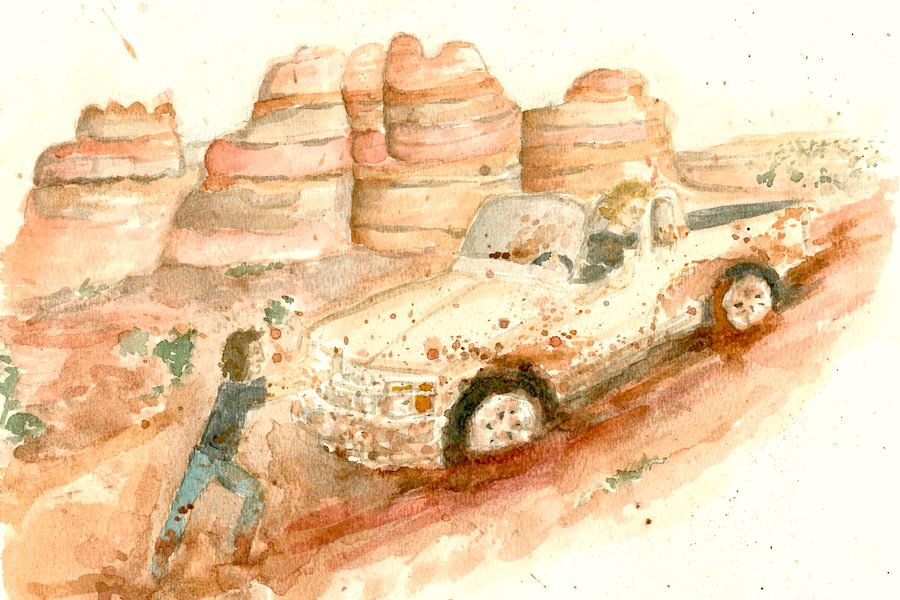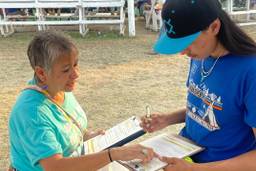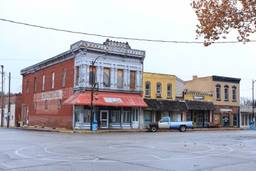
Editor’s Note: A few weeks ago, the first snows of the season came early and hard to the Yellowstone River country of south-central Montana, where I live. On a sunny day after the snowfall, I packed my camping gear and cross-country skis and set out to drive a favorite road into the mountains. I never made it. Where the road crossed a grassy and windswept hill, the gusts had blown snow into drifts a foot and a half deep, and I determined that the road was not passable. Unfortunately, I didn’t make this determination until after I had lodged my car up to the axles in one of the drifts.
In honor of the return of the season of getting stuck, Rural America In These Times is taking a short break from the cycle of ever-more-serious news to bring you something more lighthearted. I wrote this essay last winter and it was first published by the Livingston Enterprise in Livingston, Montana. I hope you enjoy it.
-Joseph Bullington, Editor of Rural America In These Times
It’s amazing how suddenly you realize that you’re a lot farther gone than you thought you were.
In that way, getting stuck is a sort of magical spell that in an instant transforms the world into a much larger and wilder place. You ride like a wayward knight, arrogant atop your trusty steed — until the dragon appears and snatches your horse from under your ass, its four legs kicking, four tires spinning pathetically in the air. One moment you’re driving along carefree, or at least care-less, an easy one- or two- or four-hour drive from the nearest house, and the next moment you find that you’re a hard day’s walk from that same house. Magic.
The roads — those umbilical cords of civilization — are still there, of course. But once you’ve planted your automobile securely in a hole of mud or snow, the roads just don’t mean the same thing they meant before. By getting stuck, you arrive, in effect, by road in a roadless area. Getting stuck is the fastest route to the middle of nowhere.
It’s been a few years since I got properly stuck but, like catching up with old friends, I got reacquainted with these thoughts this last weekend when my accomplice, Ariety, and I attempted to drive the old 4Runner to Upper Potosi, west of Pony. We planned to park where we could and ski the rest of the way into the hot springs across untracked snow, powdery and light in the subzero cold, with a bottle of red wine and glasses in my backpack. Instead, we found ourselves thrashing about with an avalanche shovel and ski pole, trying to dig the car out of a drift as the western trees smothered the last of the day’s weak light. Another lesson in the futility of making plans.
* * *
Getting stuck: “It’s the one thing you never really want to happen while driving your couch on wheels around,” says Dominic, redneck Buddha, old friend, wise man. “But when you prepare for the eventuality of being stuck it is rewarding to have that Boy Scout mentality pay off, and you can really push into some deep places.”
There was a period when getting stuck was something of a pastime for Dominic and me. I don’t remember, though, that we ever prepared particularly well for the eventuality. We would talk much of winches and land-anchors, but we didn’t have the means to build or buy them. Hell, I only remember a time or two when we had so much as a shovel.
But when things are easy, your memory tends to slide over them like a stream over mossy stones. For every hundred drives we’ve taken together, I remember but one — the one where we got stuck. And of the times we got stuck, I remember most vividly the times when we didn’t have the tools we needed. The time we dug my dad’s Subaru out of a snowy ditch south of Helena, each wielding one of my dad’s cross country skis. The time we tried to extract Dominic’s old baby blue Bronco from a mud pit using — what? A two-by-four and an ice scraper?
When we failed, Dominic carefully typed out a T9 message to his sister, Lauren, containing our location as best we could figure it, the time, and a plea for her to bring some tow straps. He then walked to the top of the highest nearby hill and, finding no cell service, proceeded to throw his flip phone repeatedly in the air, catching it each time, until the message finally caught some lost breeze of reception and delivered itself into the void. We didn’t know if it had worked until, an hour or two later, Lauren came trundling along in the old family Tahoe and pulled us out.
Each time we got stuck was different, each its own adventure. But there was one time … one time that we got stucker than we had ever been before or have been since, a time that towers in my memory above all the other times, like a monument to getting stuck. I can’t feel the car wheels start to bog down without thinking of it.
* * *
Our mission was simple: Take a plane to Denver, a Greyhound bus to Santa Fe, and retrieve there the truck of a family friend — who shall remain nameless, but who reads this paper and knows who she is. Return the truck to Livingston for her. No problem.
But it was Dominic’s and my first time in the Southwest, at least since we were children, and we weren’t exactly looking for the quickest route home. We had a map — a folding AAA production called “Indian Country” — and we’d pick a road we liked, no matter how remote or off-course it was, and drive it, winding our slow way home on back roads, sticking to dirt whenever possible.
The road looked substantial enough on the map — a firm white line leading up into the Manti-La Sal National Forest, down into the blank expanse of BLM land south of Canyonlands National Park, and then north into the Needles district of the park itself. We made our last supply stop in Blanding, Utah and then headed up into the Manti-La Sal to camp that night. Next morning we were descending into the BLM sections when a light rain began to fall.
Experienced desert-dwellers know that a rainstorm is no time to head farther into the canyon country. Washes, usually dry, flash flood with torrents of water the color of red chocolate milk and can be deadly. The roads themselves turn to impassable gumbo. Needless to say, we pushed on.
Later, when it seemed doubtful the truck would ever make it out of the state of Utah, we blamed the map — for having showed this particular road at all. And, later still, we would laugh, imagining some poor family grinding their giant RV on its one-way trip down into this gnarly country, just following a route marked on their AAA map …
* * *
We were about 50 miles as-the-car-drives from Blanding when it happened. I was driving and Dominic was saying something about how I should stay high, avoid the ruts. I was expressing my agreement when the truck’s wheels began to slide like butter slides across a hot pan. And then our long drive was suddenly over.
The driver’s side front wheel had sunk so deep in a hole of watery mud that the passenger’s side rear wheel was lifted off the ground at an ugly angle. As it continued to rain, the level of the red soup continued to rise, lapping at the bottom of my door and threatening to flood in. We tried to rock the truck — reverse, drive, reverse, drive — and dug and scooped, but the liquid mud flowed into the hole faster than we could push it out. I went searching for something — anything — firm that we could cram under the back tires, to get some purchase. I found only a BLM road sign mounted on a four-by-four post, which lifted easily from its hole in the soggy ground. It helped not at all, and I replanted it as easily as I had pulled it out.
We admitted defeat. In a storm like this, it would probably be days before anyone dared venture down this road. Best get as comfortable as we could. Wet and miserable, we decided to seek some shelter, build a fire, dry our clothes, eat some lunch. We couldn’t find a scrap of dry ground or wood and, defeated again, returned to the truck. On the way, I nearly stepped on a small rattle snake who lay, looking soggy and gray and miserable, in the grass along the road. We mused uneasily about how one wrong step could turn this inconvenience into a life-and-death emergency.
Back in the truck, we struggled to find a comfortable way to wedge ourselves in the off-kilter cab. Dominic stripped off his soaked and muddy clothes and promptly fell asleep in the passenger seat, wearing only his boxers. I sat there as the rain fell and our breath fogged the windows, reading Edward Abbey and dozing.
* * *
Voices? Impossible. I had fallen asleep. But there they were again, unmistakeable this time, and I thought I saw shapes moving through the fogged windshield. I opened my door to one of the happiest sights of my life — a souped-up, desert-runner Jeep Wrangler, complete with heavy-duty jack, winch, shovel, and two spare tires. The occupants, a father and son who had started out on the opposite end of the road, said they couldn’t promise they could get the truck out, but they hooked a tow strap to our hitch to try. And, at last, with a squelching sound, we pulled free.
We gave our saviors the last two Tecates from our cooler and piled into the truck to follow them out. Dominic took over behind the wheel. Dominic is a much better driver than I am and we both know it. He knows when to hesitate and he knows when hesitation can ruin you. He drives aggressively, because he knows what he’s doing, knows what the conditions call for. He also wrecks his cars a lot, so I never can quite trust him. In this case, though, he was the man for the job. Sorry I kicked you out of the driver’s seat, he told me later, but I knew that getting out of there was going to require that the driver do things to that truck that you, on account of your closeness to the owner, wouldn’t be capable of doing.
He was right. The road out seemed to have turned into something like bacon grease, and there was no way to hold a straight line. The truck, with its long and narrow wheel base, is not the ideal desert vehicle. Even in four-wheel-drive its hind end kept trying to pass its front end. There were places where the grease and gradient of the road were so bad that the ditch sucked us toward it like a black hole, and the only way to avoid getting stuck again was to accelerate and ram the truck into the berm with enough force to ricochet it back onto the road.
When we emerged onto the paved highway next morning, the truck bore some fresh dents, which I have yet to live down or make up for, but it was alive and so were we. I’m told that, nearly six years later, that red mud still turns up in peculiar places in the truck, remnants of that long-ago adventure.
* * *
When we at last got the 4Runner dug out of the snow last weekend, it was nearly dark so we headed back the way we had come in. We were sad to miss the hot springs, but I was glad in a way that the world had disrupted our plans. Getting stuck makes for better stories, anyway.
Joseph Bullington grew up in the Smith River watershed near White Sulphur Springs, Montana. He is the editor of Rural America In These Times.







